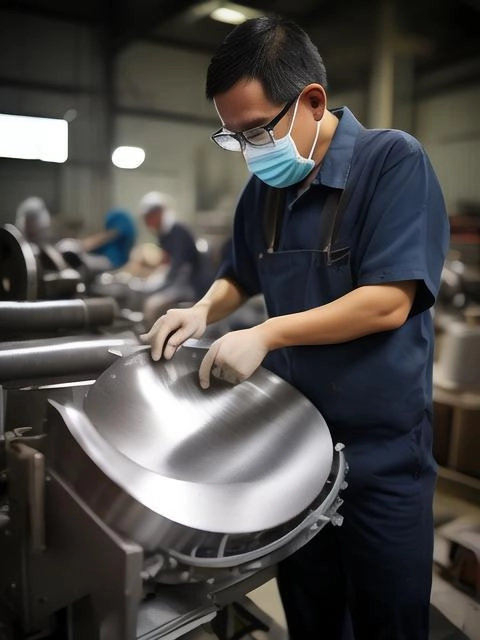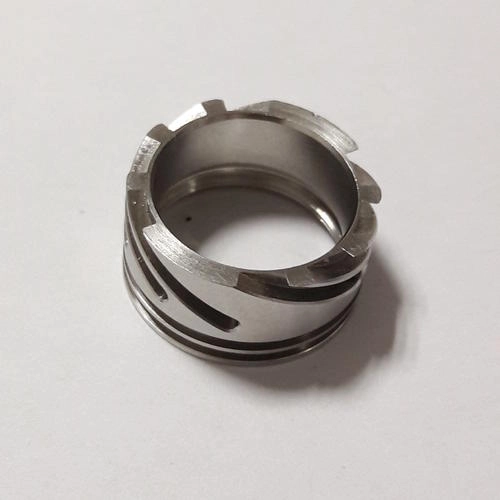JST Industrie
Bietet professionelle CNC-Bearbeitungsdienstleistungen für Edelstahl
Vorteile der Bearbeitung von rostfreiem Stahl
Die CNC-Bearbeitung von Edelstahl ist eine fantastische Wahl für die Dienstleistungen von JST Industry und wird dank seiner hervorragenden Korrosionsbeständigkeit und Festigkeit in verschiedenen Sektoren eingesetzt. Hier sind einige der wichtigsten Vorteile der CNC-Bearbeitung von rostfreiem Stahl:
Korrosionsbeständigkeit
Die Haupteigenschaft von rostfreiem Stahl ist seine hohe Korrosionsbeständigkeit, die ihn für den Einsatz in Umgebungen wie der medizinischen, lebensmittelverarbeitenden und chemischen Industrie geeignet macht.
Festigkeit und Härte
Nichtrostender Stahl hat eine hohe Druckfestigkeit und Härte und eignet sich daher für stark beanspruchte Konstruktionsteile.
Ästhetik
Edelstahl hat eine gut glänzende Oberfläche und benötigt keine Beschichtungen oder zusätzliche Oberflächenbehandlungen, um seine Ästhetik zu erhalten.
Bearbeitbarkeit
Edelstahl ist schwierig zu bearbeiten, aber JST Industry verfügt über fortschrittliche Bearbeitungstechnologie und erfahrene Techniker, die komplexe und feine CNC-Bearbeitungen durchführen können.
Eigenschaften und Anwendungen von rostfreiem Stahl
JST Industry bietet CNC-Bearbeitungsdienstleistungen für eine breite Palette von Edelstahlwerkstoffen an, um den spezifischen Anforderungen der verschiedenen Industriezweige in Bezug auf die Materialeigenschaften gerecht zu werden. Nachstehend finden Sie einige wichtige Eigenschaften von nichtrostendem Stahl und Beispiele für ihre Anwendung:

Medizinische Geräte
Wird bei der Herstellung von chirurgischen Instrumenten, Diagnosegeräten und medizinischen Betten verwendet.

Luft- und Raumfahrt
Wird bei der Herstellung von internen Flugzeugbauteilen und Befestigungselementen verwendet.
Elektronik
Für korrosionsbeständige Elektronikgehäuse und Kühlkörper.

Automobilindustrie
Für Auspuffanlagen, Bremssysteme und dekorative Teile.

CNC-Edelstahl-Bearbeitungsteile
Oberflächenbehandlungen und Veredelung von Edelstahl
JST Industry bietet nach der CNC-Bearbeitung von Edelstahlteilen eine Vielzahl von Optionen zur Oberflächenbearbeitung an, um das Aussehen, die Haltbarkeit und die Funktionalität des Produkts zu verbessern. Im Folgenden werden einige gängige Oberflächenbehandlungen vorgestellt:

Poliert: Erhältlich in verschiedenen Qualitäten von leicht poliert bis hochglanzpoliert für unterschiedliche Glanzgrade.
Gebürstet: Verleiht der Oberfläche von rostfreiem Stahl eine gleichmäßige matte Textur und wird häufig für moderne Haushaltsprodukte und Industrieanlagen verwendet.
Elektrolytisches Polieren: Entfernt durch ein elektrolytisches Verfahren winzige Oberflächenvertiefungen und verbessert so die Glätte und Korrosionsbeständigkeit von Teilen.
Passivierung: Verbessert die Passivschicht von rostfreiem Stahl, um seine Korrosionsbeständigkeit zu erhöhen.
Fälle von Edelstahlbearbeitung und Rückmeldungen
Kundenreferenzen in der Medizintechnikbranche
Hintergrund: Ein Unternehmen, das auf die Entwicklung hochwertiger medizinischer Geräte spezialisiert ist, musste eine Reihe von chirurgischen Präzisionswerkzeugen aus Edelstahl herstellen.
Kommentare des Kunden.
"Das Fachwissen und die Fähigkeiten von JST Industry in der CNC-Bearbeitung von Edelstahl waren ein großer Gewinn für uns. Sie waren in der Lage, die komplexen chirurgischen Werkzeuge, die wir entworfen haben, präzise zu fertigen, um die strengen Standards der Medizintechnikindustrie zu erfüllen. Die bearbeiteten Teile haben eine hohe Oberflächengüte und sind ohne zusätzliche Bearbeitung einsatzbereit, was unsere Markteinführungszeit erheblich verkürzt."
Fallstudie: Hersteller von Lebensmittelverarbeitungsanlagen
Hintergrund des Kunden: Ein Hersteller von Lebensmittelverarbeitungsanlagen aus Edelstahl, die den Lebensmittelsicherheitsstandards entsprechen und korrosionsbeständig sein müssen.
Beschreibung des Falls.
"Auf der Suche nach einem Lieferanten, der qualitativ hochwertige CNC-Bearbeitungsdienstleistungen für rostfreien Stahl anbietet, entschieden wir uns für JST Industry, die nicht nur hervorragende technische Kompetenz in ihren Bearbeitungsprozessen bewiesen, sondern auch eine Vielzahl von Optionen für die Oberflächenbearbeitung anboten, einschließlich elektrolytischem Polieren, um eine optimale Korrosionsbeständigkeit unserer Produkte zu gewährleisten. Darüber hinaus half uns die schnelle Lieferung von JST Industry, zeitnah auf die Marktbedürfnisse zu reagieren."
Chemische Ausrüstung Teile Verarbeitung Kundenstimmen
Kundenhintergrund: Ein Unternehmen, das maßgeschneiderte Anlagen für die chemische Industrie herstellt, musste Teile aus hochtemperatur- und korrosionsbeständigem Edelstahl bearbeiten.
Kommentare der Kunden.
"Die CNC-Bearbeitungsdienstleistungen von JST Industry erfüllten nicht nur unsere Anforderungen an Material und Genauigkeit, sondern halfen uns auch, unser Teiledesign durch professionelle Beratung zu optimieren. Der Service von JST Industry war sehr aufmerksam und hat uns bei jedem Schritt, von der Materialauswahl bis zur Fertigstellung der Bearbeitung, ausführlich unterstützt.
FAQs
F: Ich entwerfe ein neues Produkt, das eine CNC-Bearbeitung erfordert, um einen Prototyp und ein Endprodukt herzustellen. Wie wähle ich das am besten geeignete Material für die CNC-Bearbeitung für mein Projekt aus?
A: Wir bei JST Industry wissen, dass die Wahl des richtigen CNC-Bearbeitungsmaterials für das Produktdesign entscheidend ist. Sie sollten zunächst das Szenario berücksichtigen, in dem Ihr Produkt eingesetzt werden soll, einschließlich der erforderlichen mechanischen Eigenschaften, Temperaturbeständigkeit, Korrosionsbeständigkeit und Kosteneffizienz. Wir bieten eine breite Palette von Werkstoffen an, unter anderem Aluminiumlegierungen, Edelstahl, Messing, verschiedene Legierungen und viele Kunststoffe. Unser Expertenteam unterstützt Sie bei der Auswahl des für Ihre spezifischen Anforderungen am besten geeigneten Materials und berät Sie bei der Designoptimierung, um einen effizienten und kostengünstigen CNC-Bearbeitungsprozess zu gewährleisten.
Q: Ich würde gerne wissen, wie sich die Auswahl verschiedener Materialien bei der CNC-Bearbeitung auf die endgültigen Bearbeitungskosten auswirkt?
A: Wir bei JST Industry wissen, dass die Materialauswahl einen erheblichen Einfluss auf die CNC-Bearbeitungskosten hat. Die Art des Materials, die Schwierigkeit der Bearbeitung und die Marktverfügbarkeit wirken sich alle auf seinen Preis aus. So wird beispielsweise Stahl aufgrund seiner geringeren Kosten häufig verwendet, während Titanlegierungen und bestimmte hochentwickelte Legierungen aufgrund ihrer höheren Materialkosten und Bearbeitungsschwierigkeiten teurer sind. Darüber hinaus wirkt sich auch die Bearbeitbarkeit des Materials auf die Kosten aus, z. B. sind Aluminiumlegierungen aufgrund ihrer leichten Bearbeitbarkeit in der Regel preiswerter. Unser Kostenvoranschlagssystem berücksichtigt all diese Faktoren, damit Sie einen möglichst genauen Kostenvoranschlag erhalten.
Q: Welche Konstruktionsverfahren können mir helfen, die Bearbeitungskosten bei der Konstruktion von CNC-bearbeiteten Teilen zu senken?
F: Ich habe strenge Anforderungen an die Genauigkeit meiner Produkte. Welche Toleranzen können mit CNC-Bearbeitung erreicht werden und wie wirkt sich dies auf die Qualität des Endprodukts aus?
A: Bei JST Industry sind unsere CNC-Bearbeitungsdienste in der Lage, extrem hohe Toleranzen einzuhalten, oft bis zu ±0,01 mm, dank unserer fortschrittlichen Bearbeitungsausrüstung und strengen Qualitätskontrollverfahren. Diese hochpräzise Bearbeitung gewährleistet die Konsistenz und Zuverlässigkeit der Teile, was besonders wichtig für Baugruppen ist, die eine hochpräzise Passung erfordern. Unser Qualitätssicherungssystem umfasst mehrere Prüfungen und Kalibrierungen, um sicherzustellen, dass jedes Teil mit den Konstruktionszeichnungen und Toleranzen des Kunden übereinstimmt und somit die Qualität des Endprodukts gewährleistet ist.





